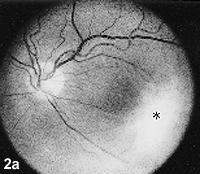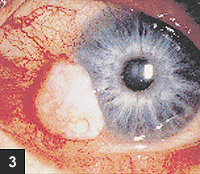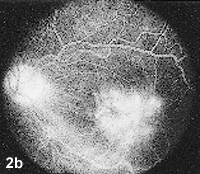Ocular complications of AIDS dropping
But HIV incidence is growing overall, and physicians are worried about possible resistance to HAART drugs.
Highly active anti-retroviral therapy (HAART) has markedly decreased the opportunistic infections at the heart of most ophthalmic consequences of AIDS. This therapy has proven so successful that the new incidence of some ophthalmic diseases has dropped to almost nonexistent levels in patients with access to HAART.
Allen B. Thach, MD, is a retinal specialist at Walter Reed who also heads the eye clinic at the Whitman-Walker Clinic in Washington, which serves HIV patients. In his experience, the number of patients presenting with opportunistic eye infections has decreased by much greater than one-half since the introduction of HAART in 1996.
Despite the advance, AIDS continues to threaten new populations.
Worldwide, more than 30 million people have HIV, mostly in Africa and Southeast Asia, including India. In North America nearly a million people are HIV positive, and one-quarter of them have AIDS. About one-half do not know they are HIV positive.
Although the number of people dying from AIDS has decreased dramatically, the number of people contracting HIV is actually increasing. And AIDS is no longer the "gay plague" — it has made large increases among college-aged women, blacks and Hispanics.
According to Emmett T. Cunningham Jr., MD, PhD, MPH, of San Francisco, “The population at risk for all these complications is actually increasing, but it’s being held at bay by combination therapy.”
And just as HAART changed the incidence of opportunistic disease, it has changed how ophthalmologists treat infected patients. Former threats such as cytomegalovirus (CMV) retinitis are no longer as devastating to patients on HAART, but they can still blind patients as the body relearns to fight the infection.
Shifting target
|
| ||||
Dr. Cunningham did his residency training at the University of California at San Francisco during the height of the AIDS epidemic. His fellowship was at the Francis I. Proctor Foundation, where he focused on infectious and inflammatory eye disease. About 80% of his practice is uveitis and the remainder is AIDS related.
“Today in San Francisco, none of us are seeing a tremendous amount of AIDS-related eye disease because combination therapy has decreased the prevalence,” he said.
Ophthalmologists still treat patients, but as their immune systems get stronger, they have fewer day-to-day problems with opportunistic infections and neoplasms, Dr. Cunningham said.
But the disease is shifting, both as a social problem and as a viral entity.
“Whereas this was a problem of gay white men 10 years ago, it’s shifting into women and minorities, particularly blacks and Hispanics. The demographics are really changing,” he said.
Of all the AIDS patients in the United States, about 87% of them already use HAART, according to Pravin U. Dugel, MD, in practice in Phoenix. The other 13% either cannot tolerate the side effects or have no access to the medical system.
Previous success

| ||||
HAART was so effective in gay white males that it significantly decreased the need for ophthalmic-specific treatments, Dr. Dugel said. Eye physicians encouraged internists to beware of possible future systemic resistance and to follow patients closely.
However, the disease has put a new population at risk, as it spread from the gay community to minorities and women. Also, the developing world has seen little of the expensive cocktail therapies that have proven so successful in keeping HIV-positive patients healthy.
(Editor’s note: Look for a more thorough discussion of AIDS and the eye in the developing world in an upcoming issue of Ocular Surgery News International Edition.)
And lurking in the cells of AIDS patients are the possible combinations of resistant HIV strains that could evade even HAART.
Dr. Dugel is the retinal specialist in his Phoenix practice. CMV used to be his most common referral for AIDS patients, until HAART. Now the incidence has dropped from 40% to about 3%.
It was not always so
In the 1980s, CMV retinitis was a death sentence, he said. Patients lived about 6 weeks after its diagnosis. The presentation was a whitening of the retinal layer with blood present, giving it a "ketchup and cottage cheese" appearance that was extremely florid on the retina.
CMV also affected the optic nerve or caused retinal detachments, blinding patients in their last weeks of life. Physicians gave daily intravenous injections of anti-CMV drugs.
A huge lifestyle change
 ---41-year-old male with large squamous cell carcinoma of the conjunctiva, left eye. Due to presence of tumor, the patient was tested and found to be HIV positive.
---41-year-old male with large squamous cell carcinoma of the conjunctiva, left eye. Due to presence of tumor, the patient was tested and found to be HIV positive.
COURTESY OF CAROL L. KARP, MD.
Today HAART patients diagnosed with CMV retinitis live longer, by an average of 2 years, compared with the 1-year average for patients on zidovudine (AZT, Retrovir, Glaxo Wellcome), Dr. Thach said.
Dr. Dugel added that patients have lived 15 years after initial diagnosis, and presumably can live much longer. So physicians have to look for CMV not only in the posterior pole, but also in the periphery. Here, the ketchup and cottage cheese appearance is more granular, with less blood.
CMV usually presents in patients who cannot tolerate HAART or have left the regimen. In these patients, it starts in the periphery and begins to diminish vision from there.
His most common referral stems from patients who had been doing well until CD4+ T-lymphocyte cell counts gradually declined. These patients will complain of floaters or decreased vision. An ophthalmic exam typically reveals peripheral CMV retinitis with visual acuity of 20/50.
Caught early, Dr. Dugel said, central vision can be saved with 2 weeks of loading doses of intravenous ganciclovir or foscarnet.
Then he discusses with the patients whether to continue with maintenance doses or implant a ganciclovir device and take oral ganciclovir for systemic protection.
He confers with an internist, who attempts to raise the CD4 count above 150 cells/mm³. If the internist can accomplish that, then further ophthalmic treatments may not be necessary. However, the patient must still be followed very closely for any relapses.
“I have lots of patients in whom I’ve never had to implant another device because after 8 months their T cell count is high enough that the CMV stays inactive,” Dr. Dugel said.
Dr. Thach added cidofovir (Vistide, Gilead Sciences) to his armamentarium to reduce the reliance on daily intravenous therapies. Cidofovir offers once a week dosing for induction followed by every 2 weeks for maintenance.
“That was a huge change in the lifestyle of the way these patients would be treated,” Dr. Thach said. “The other big change that came along was the ganciclovir implant. That was a great advantage. You can release a relatively high dose of ganciclovir into the vitreal cavity for a prolonged period of time.”
The implant allowed surgeons to give a higher dose directly into the eye. This enabled surgeons to control the disease for a longer period of time and to reduce the chance that organisms would develop resistance.
Immune recovery
Since the advent of HAART therapy, more than one-half of the treated population has experienced immune reconstitution — a long-term strengthening of the immune system. These patients have a dramatically lower risk of infections or neoplasms, Dr. Cunningham said.
HIV debilitates the body’s immune system by preferentially targeting the T cells that fight infection. HAART allows the body to rebuild T cells and, with time, the body relearns how to fight infections.
Patients can heal their own CMV retinitis, for example, and are then at much less risk to contract it again. But the body’s renewed fight against CMV retinitis can cause uveitis, Dr. Cunningham said.
“Normally, CMV causes very little inflammation, but when your immune system gets stronger, you don’t actually suffer from the infection itself but from the body’s fight against the infection,” he said. “This causes a lot of inflammation, cystoid macular edema, epiretinal membranes, tractional retinal detachments or neovascularization.”
Studies report uveitis in anywhere from 20% to 50% of immune reconstitutive patients. When the condition affects vision, Dr. Cunningham attempts a regimen of cortical steroids. The goal is to treat the inflammation while letting the body continue to control the infection.
However, physicians have not had a chance in the past 2 years to adequately study the new condition. They are now trying drops, oral drugs and even periocular injections to fight it.
“Physicians have tried all forms and had some success with each,” he said. “Sometimes the success is limited, even with all measures tried.”
No single treatment
While HAART therapy has diminished the most common opportunistic infections, many rare conditions still occur among AIDS patients.
Progressive outer retinal necrosis (PORN) is a swift and devastating disease that advances from the periphery toward the center. According to Dr. Dugel, the condition is often bilateral and results from systemic infection.
According to Dr. Thach, PORN results from the herpes family of viruses. Unlike CMV, which progresses at a slow rate, PORN can blind patients within weeks, and there is no single reliable treatment. The most often used regimen combines ganciclovir with either acyclovir or foscarnet.
“The disease is so devastating and can lead to significant loss of visual acuity,” Dr. Thach said. “Single drug use almost without fail will not treat these patients.”
And patients who develop CMV and PORN incur the risk of detachments.
“When patients weren’t living very long, we weren’t excited about taking them out to surgery and performing a major operation,” he said. “Now that patients are living longer, we are doing surgery for retinal detachments to preserve whatever vision we can.”
Another infrequent ophthalmic effect is Kaposi’s sarcoma, a rare tumor that affects the eyelids or conjunctiva.
As the AIDS epidemic started in the 1980s, five men presented with Kaposi’s in a New York clinic and became one of the first groups diagnosed as being immunodeficient, Dr. Thach said.
Dr. Dugel conducted some of the primary work on treating Kaposi’s of the conjunctiva. Surgery could remove lesions, depending upon the stage of the disease. Cryotherapy, radiation and systemic therapeutic agents augmented procedures for the more advanced cases.
Kaposi’s may have an infectious origin, Dr. Dugel said. New research suggests a herpes virus could cause it.
The men in New York were not the only group who experienced uncommon tumors commonly. Carol L. Karp, MD, a corneal specialist at the Bascom Palmer Eye Institute in Miami, described how the appearance of conjunctival neoplasia led her to diagnose HIV in Miami residents.
An unusually large number of young patients presented at the Bascom Palmer Eye Institute with corneal and conjunctival intraepithelial neoplasia or squamous cell carcinoma. These are rare cancers and are traditionally seen in elderly individuals. It was thought to be an indicator of lifelong exposure to sunlight, and perhaps to human papilloma virus (HPV). The diseases were presenting in younger patients too frequently to be a coincidence.
“We looked at the atypically young patients with tumors on the eye, and we tested them serologically,” she said. “We found that 50% of patients under 50 years old with a conjunctival tumor were HIV positive.”
Once again, physicians suspect viruses take advantage of the decrease in the immune status, which may lead to a more permissive environment for squamous cell and intraepithelial neoplasia, she said. HPV is sexually transmitted and is thought to cause venereal warts and cervical and anal intraepithelial neoplasia. It also may play a role in the development of conjunctival tumors.
Dr. Karp treats her patients surgically, with the gold standard treatment being surgery and cryotherapy. But several patients at the time had a short expected life span and did not want to undergo another surgery.
This led Dr. Karp to try interferon alfa 2B injections and topical drops to treat the tumors, with excellent success. Interferons (alpha 2A) also have been used for Kaposi’s. These drugs seem to bolster the body’s immune system, which rids the body of tumors. Although the exact mechanism of action is unknown, these drugs appear to have antineoplastic and antiviral effects. They have been successfully used for squamous cell carcinomas of the skin, cervical intraepithelial tumors and hepatitis.
| Treatments for cytomegalovirus retinitis | |||
| Drug* | Median time to progression (Mo) | Advantages | Disadvantages |
| Intravenous ganciclovir | 1.5 to 2.5 | Protects other eye and distant organs | Systemic side effects common; requires daily infusions |
| Oral ganciclovir | 1 to 1.5 | Protects other eye and distant organs | Requires frequent daily doses; lower systemic and intraocular drug levels; shorter median time to progression than with intravenous therapy |
| Intravitreal ganciclovir injection | Not supplied | Permits immediate intraocular delivery of high doses | Requires frequent injections; does not protect other eye or distant organs |
| Intravitreal ganciclovir implant | 6 to 8 | Permits intraocular delivery of high doses; long duration | Does not protect other eye or distant organs; moderate, transient visual loss for 2 to 4 weeks after surgery |
| Intravenous foscarnet | 1 to 2 | Protects other eye and distant organs | Systemic side effects common; requires daily infusions |
| Intravitreal foscarnet injection | Not supplied | Permits immediate intraocular delivery of high doses | Requires frequent injections; does not protect other eye or distant organs |
| Combined intravenous ganciclovir and foscarnet | 4 to 5 | Longer time to progression than with either drug alone; maximal protection of other eye and distant organs | Combined side effects; requires long daily infusions |
| Intravenous cidofovir | 3 | Eliminates need for indwelling catheter; protects other eye and distant organs | Potential for severe nephrotoxicity, especially in patients with prior kidney disease or susceptibility to dehydration; uveitis and low intraocular pressure common |
| *These drugs may be contraindicated or the doses may need to be reduced in patients who are prone to dehydration, have reduced creatinine clearance with documented neutropenia or thrombo cytopenia, or are receiving concurrent treatment with other myelotoxic or nephrotoxic drugs. | |||
A deceiving lull
Today, physicians question the administration of HAART, just as they do penicillin or quinolones. Will common administration lead to fiercer, more resistant strains of HIV?
“That’s the fear that all of us have — that there’s a lull right now, but there may be a point when we get resistant forms of the organism,” Dr. Dugel said. “We may see CMV less frequently, but what we see may be more difficult to treat because it may be more resistant. No one really knows at this point.”
The epidemic is not over by any means, Dr. Cunningham said.
“The numbers are still climbing and we don’t know what’s going to happen to this increasing pool of HIV-positive patients if the current medications turn out to be no good in the long term,” he said. “Two years ago, we wouldn’t have been able to predict that immune recovery uveitis would have been important. It may be that, over time, if we don’t come out with new and better HAART therapies, most patients will break through and become resistant, and we will have a huge flood of opportunistic infections, including CMV.”
For Your Information:
- Emmett T. Cunningham Jr., MD, PhD, MPH, practices at the Francis I. Proctor Foundation and the University of California, San Francisco. He can be reached at the Department of Ophthalmology, University of California Medical Center, San Francisco, CA 94143-0944 U.S.A.; +(001) 415-476-1442; fax: +(001) 415-502-2521; e-mail: emmett@itsa.ucsf.edu. Dr. Cunningham has no direct financial interest in any of the products mentioned in this article, nor is he a paid consultant for any companies mentioned.
- Pravin U. Dugel, MD, practices at 2720 N. 20th St., Ste. 225, Phoenix, AZ 85006 U.S.A.; +(001) 602-222-2221; fax: +(001) 602-266-2044. Dr. Dugel has no direct financial interest in any of the products mentioned in this article, nor is he a paid consultant for any companies mentioned.
- Allen B. Thach, MD, can be reached at Walter Reed Army Medical Center, Washington, DC 20307 U.S.A.; +(001) 202-782-6964; fax: +(001) 202-782-6156; e-mail: jathach@erols.com. Dr. Thach has no direct financial interest in any of the products mentioned in this article, nor is he a paid consultant for any companies mentioned.
- Carol L. Karp, MD, practices at the Bascom Palmer Eye Institute, 900 N.W. 17th St., Miami, FL 33136 U.S.A.; +(001) 305-326-6156; fax: +(001) 305-326-6417. Dr. Karp has no direct financial interest in any of the products mentioned in this article, nor is she a paid consultant for any companies mentioned.



